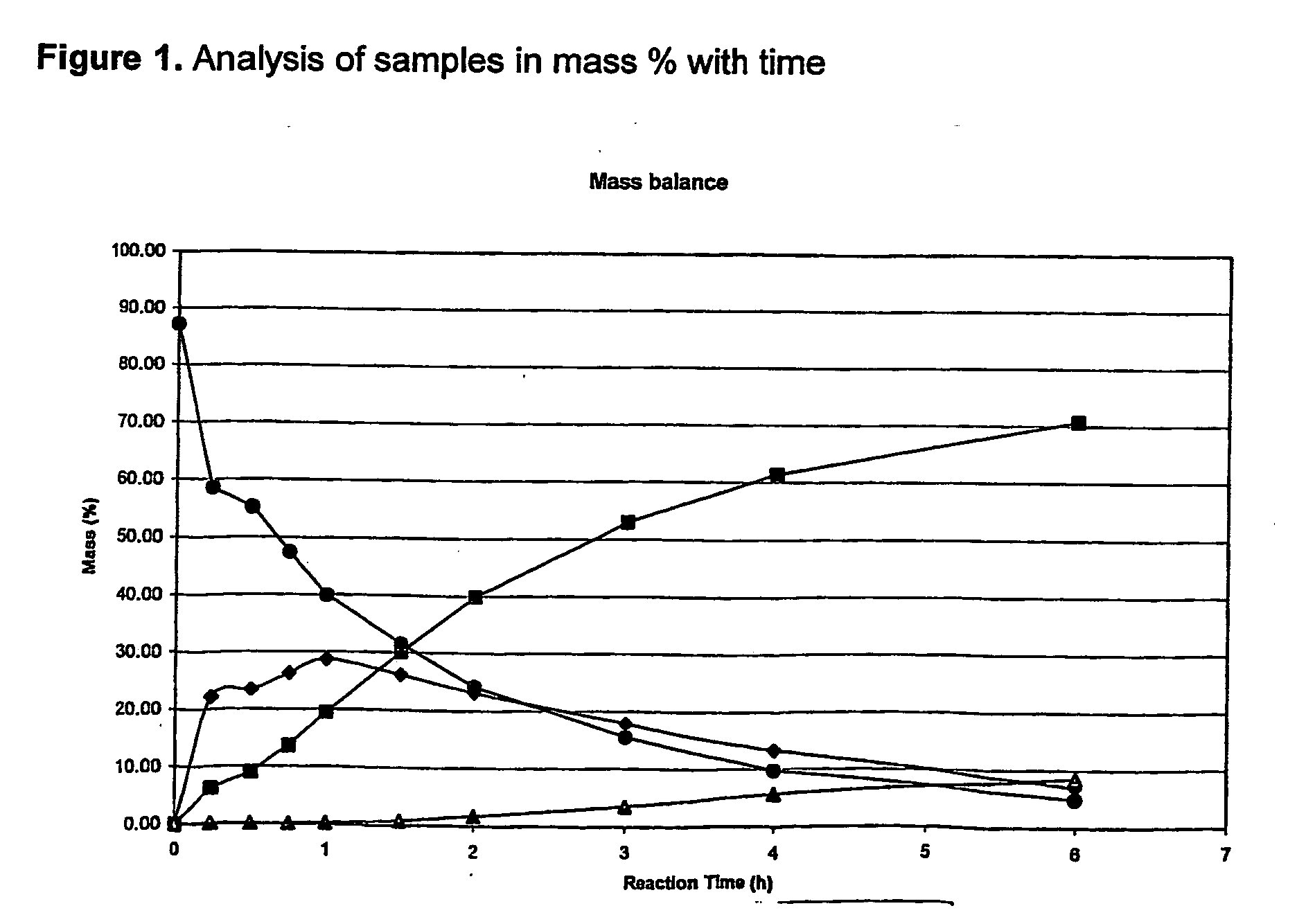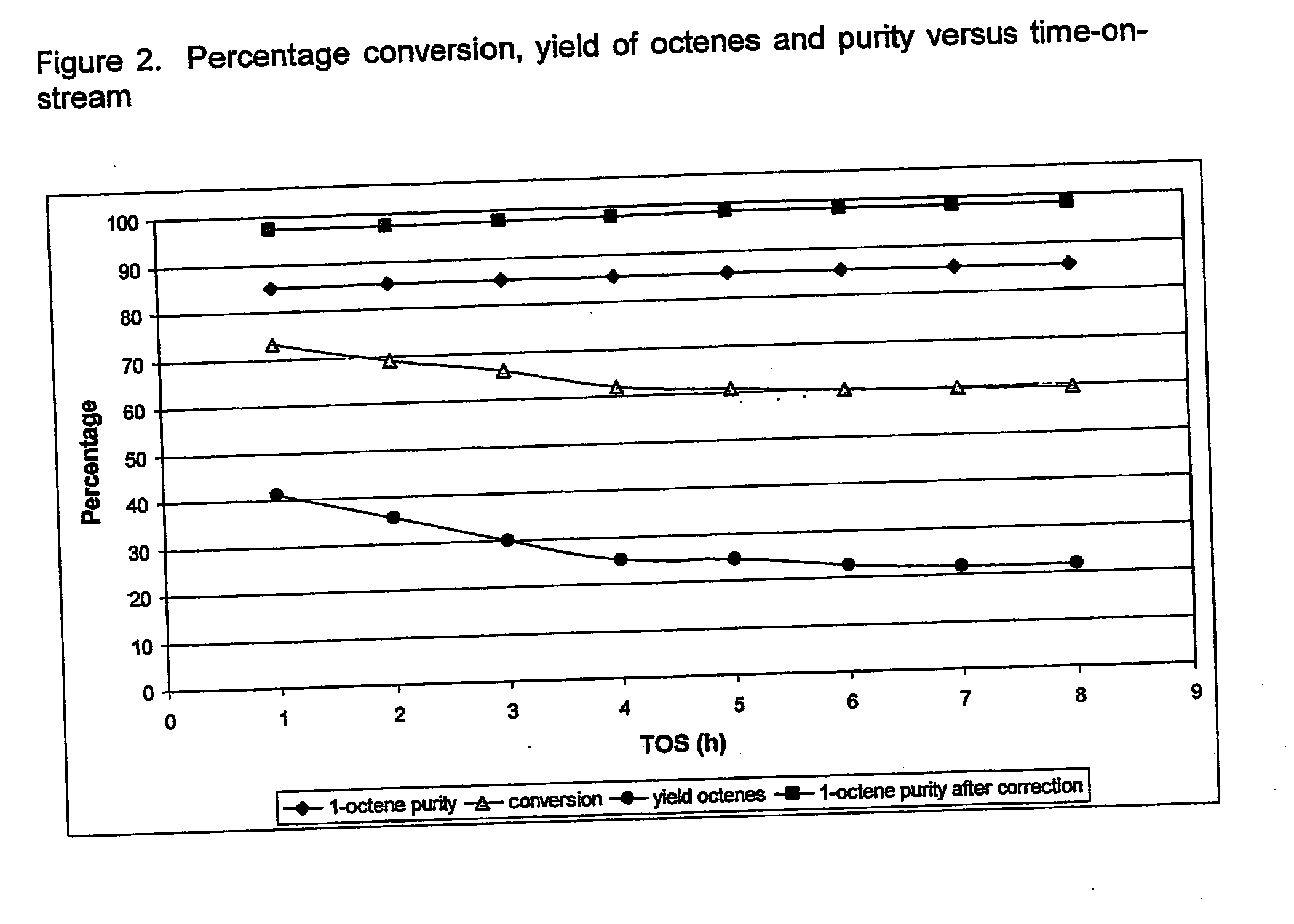Method of increasing the carbon chain length of olefinic compounds
a technology of olefinic compounds and carbon chains, which is applied in the preparation of organic compounds, hydrocarbon preparations, hydrocarbons, etc., can solve the problems of inability to control the reaction, the metathesis reaction is accordingly not very suitable for preparing -olefins, and the technology is suffering from equilibrium and selectivity limitations, etc., to increase the carbon chain length of an olefinic compound, increase the carbon chain length, increase the effect of the carbon chain length
- Summary
- Abstract
- Description
- Claims
- Application Information
AI Technical Summary
Benefits of technology
Problems solved by technology
Method used
Image
Examples
example 2
Hydroformylation of 1-Pentene Using a Rhodium Catalyst
Run 1
A 300 ml Parr autoclave with a 50 ml mounted feed bomb was used. The autoclave was loaded with 100 ml toluene (solvent), ˜0.02415 g Rh (acac) catalyst pre-cursor (˜35 mg / l Rh in 150 ml liquid volume in the autoclave) and 1.028 g TPP (i.e. 1:80 Rh(acac)(CO)2:TPP ratio) and heated to 80° C. under 5 bar syngas (molar ratio CO:H2 being 1:1) pressure and 750 rpm stirring speed for ˜45 minutes. While the reaction was heating up, 50 ml 1-pentene was loaded into the feed bomb under 6 bar syngas (connected to the gas reservoir) at room temperature with the valve to the autoclave closed. After 45 minutes, the reaction was initiated by pressuring the system with 6 bar syngas (molar ratio CO:H2 being 1:1).
Run 2
The experiment was then repeated by using the exact same conditions as described above, but with an impure 1-pentene feedstream of the composition as set out in Table 4.
TABLE 4COMPOUNDMASS %non-oxo-reactive olefins (viny...
example 3
Dehydration of the Formed Alcohol
In a vertical pipe reactor 400 mm in length and 25.4 mm inner diameter, a catalyst bed of about 12 grams of gamma-Al2O3 was loaded, supported on quartz wool. The reactor was heated to 315° C. and 1-hexanol (98% pure) was fed into the reactor at a LHSV of 5 hr−1 at atmospheric pressure. The reactor product (after removal of water and hexenes) was recycled to the reactor at a mass ratio of feed:recycle of 0.75: 2.0. A total of 94% of the 1-hexanol was converted to alkenes, with a selectivity towards hexenes of 98.6%, of which 97.5% was 1-hexene.
example 4
Production of 1-Hexene From 1-Pentene
Step 1: Hydroformylation of 1-Pentene
An impure pentene feedstream derived from a Fischer-Tropsch synthesis reaction containing 70 mass % 1-pentene, trace amounts of internal and branched olefins and the balance C5 paraffin was subjected to modified cobalt catalysed hydroformylation. The feedstock (6I) along with a stock solution containing: 300 ppm Co(II)octanoate, eicosyl phoban (EP) as ligand and LABS as a surfactant at a ligand:metal:LABS ratio of 3:1:0.1 was added to a 11 l stirred tank reactor (PDU) under inert nitrogen atmosphere. The stirred tank reactor was pressurised to 85 bar with syngas (molar ratio of H2:CO being 2:1) with the gas fed at a rate of 1 l / min and then heated to 170° C. Approximately 5 l of product was drained per batch. The composition of the crude hydroformylation reaction product is presented in Table 6.
TABLE 6Hydroformylation productOlefin conversion (mass %)Linear C595.6Total C5 conversion93.7Product Compositio...
PUM
| Property | Measurement | Unit |
|---|---|---|
| temperature | aaaaa | aaaaa |
| temperature | aaaaa | aaaaa |
| boiling points | aaaaa | aaaaa |
Abstract
Description
Claims
Application Information
 Login to View More
Login to View More - R&D
- Intellectual Property
- Life Sciences
- Materials
- Tech Scout
- Unparalleled Data Quality
- Higher Quality Content
- 60% Fewer Hallucinations
Browse by: Latest US Patents, China's latest patents, Technical Efficacy Thesaurus, Application Domain, Technology Topic, Popular Technical Reports.
© 2025 PatSnap. All rights reserved.Legal|Privacy policy|Modern Slavery Act Transparency Statement|Sitemap|About US| Contact US: help@patsnap.com


